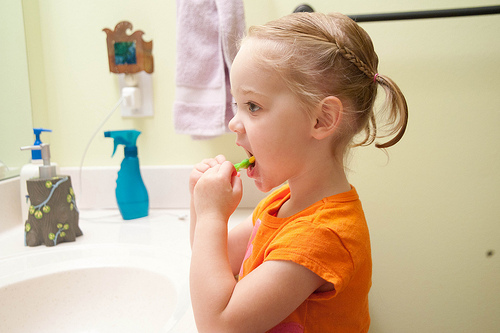 My son started Kindergarten this year and this was a big transition for our family. To transition to a new schedule we made adjustments over time. We didn’t start the new routine the week school started—that would’ve been chaos. Change takes time. We had to adjust bedtimes, eliminate naps, wake up earlier, and establish a new consistent routine. It took a while to get used to and quite a bit of coaching our kids through the transition, but now they are pros at getting ready for school in the morning. It takes planning and preparation for mornings to go smoothly. I make my oldest son’s lunch and lay out both boys’ clothes the night before. In the morning my boys know exactly what to expect, first they eat breakfast, then they brush their teeth, then they get their clothes on and if they have time to spare they can play until it’s time to leave.
My son started Kindergarten this year and this was a big transition for our family. To transition to a new schedule we made adjustments over time. We didn’t start the new routine the week school started—that would’ve been chaos. Change takes time. We had to adjust bedtimes, eliminate naps, wake up earlier, and establish a new consistent routine. It took a while to get used to and quite a bit of coaching our kids through the transition, but now they are pros at getting ready for school in the morning. It takes planning and preparation for mornings to go smoothly. I make my oldest son’s lunch and lay out both boys’ clothes the night before. In the morning my boys know exactly what to expect, first they eat breakfast, then they brush their teeth, then they get their clothes on and if they have time to spare they can play until it’s time to leave.
It has made a huge difference in our family that we’ve established a pretty good routine. Without a routine to follow my children and I would never make it on time—anywhere. I have found that it is important to be proactive and involved with my kids every step along the way. You can’t expect children to get ready on their own the first time you ask; it takes a while of consistently doing it with them, hands on, right beside them, before they can do it efficiently and independently. I still give reminders to get my kids back on track when they get distracted but it is easier now with a consistent routine than it was a several months ago.
To be honest we’ve had our share of temper tantrums and meltdowns. We’ve had to learn what their triggers are and plan around them. My youngest son is four, and he used to ask me to help him put his clothes on all the time. This was frustrating because I knew he could do it on his own and if I insisted that he could do it himself, he threw a fit. I was missing the big picture. I finally realized that he needed extra attention from me in the morning, so I laid aside time to attend to his needs and the fits stopped. Over time he didn’t need help with his clothes as much anymore because I was able to recognize his need for attention and meet that need in other ways. There are still some days when he asks me to help him put his clothes on and instead of seeing this as an inconvenience or an act of defiance, I attune to his needs and help him. This is my son’s way of reminding me that I need to slow down and give him attention.
There are different ways to help children through transitions. Talking about transitions in advance helps children feel prepared for upcoming events. For example, to prepare for an upcoming trip to the beach it may be helpful to your child for you to describe what the weather will be like, the sand on the beach, and the waves of the ocean so the child has an idea of what to expect. It’s also helpful to give reminders with time frames. You can countdown to a special event by marking days off on a calendar or using a countdown paper chain. For day to day transitions it helps to give frequent reminders like “you can play for five more minutes, then we’re going to eat dinner,” and continue to give incremental reminders as it gets closer to the time to transition.
Another way to prepare a child for transitions is to use pictures or story books. The library has books that are helpful to help a child with almost any transition. Lifebooks or memory books are great for children to help them understand where they’ve been and where they’re going. On our refrigerator we have a white dry erase board and one day my husband started drawing pictures of the daily activities that the kids needed to accomplish and a place for them to check it off when they got it done. Our boys loved this! Next thing I know they are making their own list with their own drawings. My husband is a list maker and he always reminds me that your body releases endorphins when you check items off your list. My kids don’t always need the check list anymore for getting ready in the morning but we use checklists for other things now like chores; however, instead of drawing the pictures every time I printed them off on the computer, laminated them and put a magnet on the back so we can reuse them.
Having a routine is helpful for any child; however, Trust-Based Relational Intervention® (TBRI®) teaches that children from “hard places” particularly benefit from having a consistent routine. When a child knows what to expect they feel safe, and are less afraid of what will happen next. Transitions are part of everyday life and it is important to give your children the tools they to be successful, and don’t forget to cheer them along every step of the way.
Photo Credit: Matt Bauer
For more information about MLJ Adoptions’ international adoption programs, please click here.
